
12 Best Lunch Spots In Napa
Best Lunch In Napa – Our 12 Favorite Spots! Lunch is a must when you’re out wine tasting! Whether you’re in the mood for a
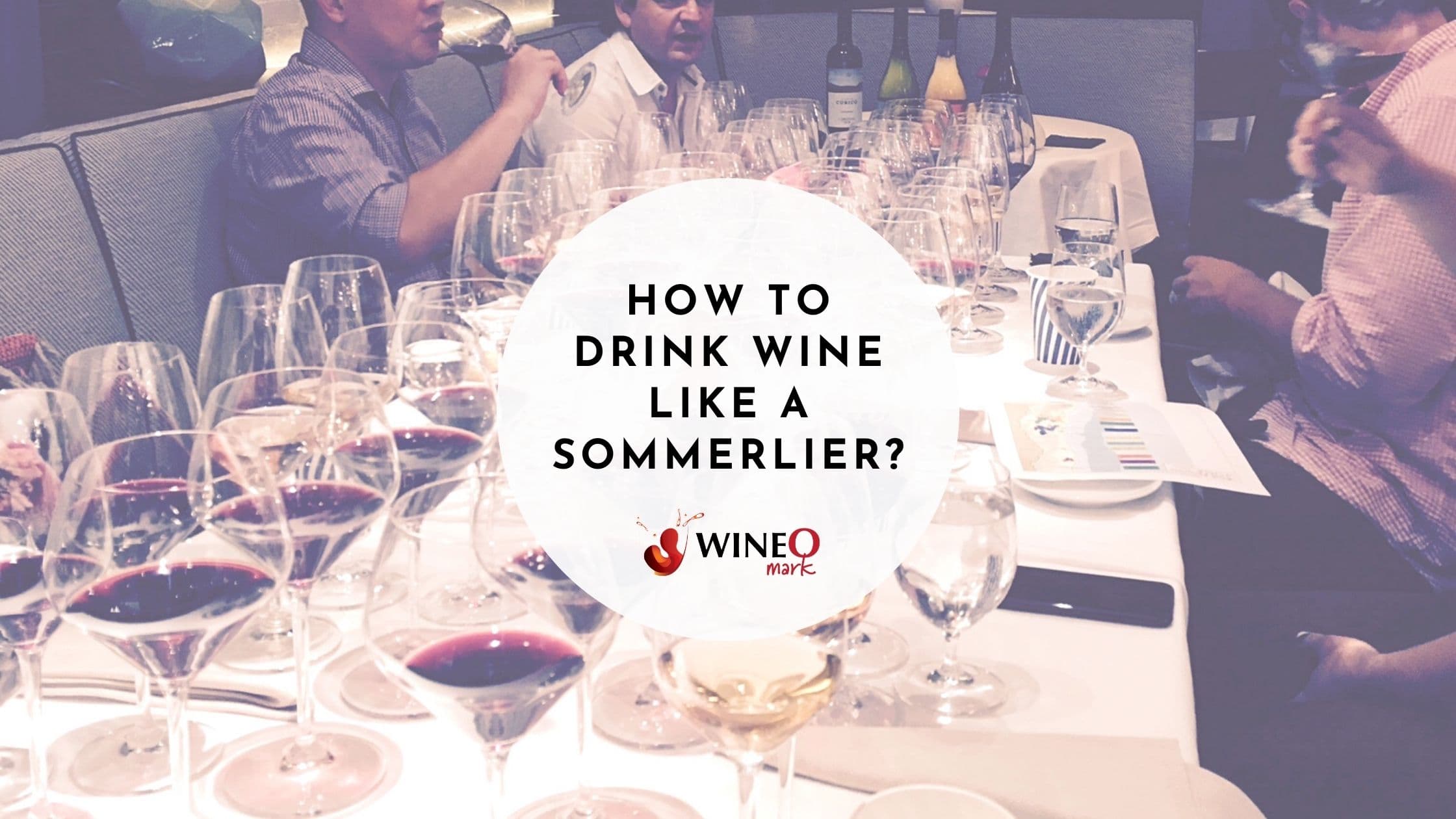
“How do I look cool drinking wine?”
This was the most asked question I received while hosting over 700+ wine events in NYC. Everyone seems to think that being a fancy wine drinker requires an encyclopedic knowledge of wine or some secret ability to discern particular tastes.
However, the fact is you are cool just because you are drinking wine! And if you are able to truly enjoy it, then there is nothing cooler than that.

As a certified sommelier, I went through a lot of training and passed a certification exam. But you don’t need all that to be great at tasting wine.
All it takes is confidence, a little bit of knowledge, and three simple steps.
There are plenty of tips for looking “cool” while drinking but the easiest way to drink wine is to approach it the same way as what you would do when you eat and enjoy food.
You eat with your eyes first, smell the food, then you eat it and enjoy it.
Imagine an In N Out burger, once you get a hold of it…
It looks great.
Once get a whiff of the food, smells great.
And of course, once you eat it, tastes great.
So it’s the same thing with wine.
You drink with your eyes first, swirl the wine (one additional step), smell the wine, then you drink it and enjoy it!
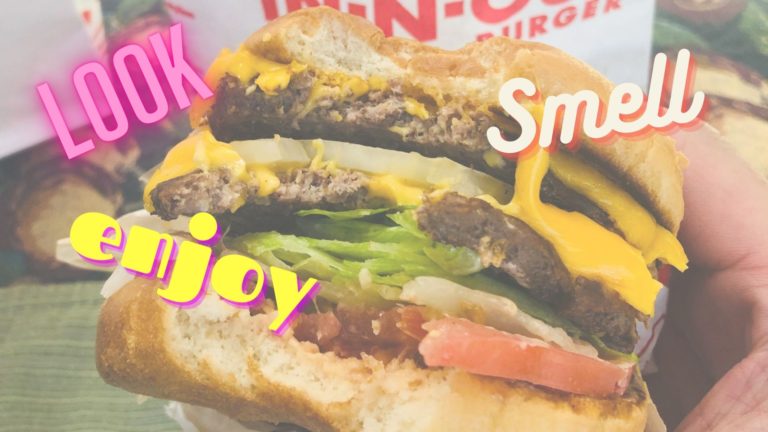
But of course the first step to drinking wine is to know about the different wine regions and varietals. If you don’t know anything about what you’re eating it’s much harder to enjoy it, and it’s the same thing with wine.
I’ve put together a basic list of wine types that covers the wines you’ll most likely encounter with some main takeaways for each wine type. You don’t need to remember everything, but knowing something about the wine you’re drinking will help enormously when you’re tasting the wine.
Red, White, Sparkling, and Others listed from most common to least common.
Cabernet Sauvignon – Cabernet grapes are not only the most planted grape in the world, but they also makes some of the best wines in the world! They are some of the most complex, full-bodied, bold wines that one can buy. Popular regions for Cabernet include Bordeaux (Left Bank), Napa Valley, and Chile.
Merlot – Merlot is the best value wine right now. Known as the other Bordeaux variety (Right Bank), and often overshadowed by Cabernet Sauvignon, this is the 2nd most planted grape in the world. Furthermore, the famous and popular wine movie, “Sideways” made Merlot sound like the worst variety. But in reality it’s a great grape that can also produce some of the best wine that can stand up with the best Cabernets.
Pinot Noir – My favorite wine variety is Pinot Noir. This grape is most well known for their great wines in France’s Burgundy region, which (in my opinion) is the best region of wine in the world. Pinot Noir is more popularly known in the US as light body fruit forward wine. Russian River Valley in Sonoma and Willamette Valley in Oregon are two of the most popular wine regions in North America for Pinot Noir.
Syrah/Shiraz – With Syrah I think of a bold, peppery, and spicy red wine that originates from the Rhone Valley of France. That variety has also become popular in Chile, South Africa, and California. With Shiraz (same exact grape, just a different name) I think of the most popular and best-tasting wine in Australia.
Zinfandel – Many have confused zinfandel with white zinfandel, the pink wine known for its sweetness. Very popular in California wine regions, this wine is juicy, spicy, and jammy.
Malbec – Malbec is generally considered to be the national grape variety of Argentina, and is specifically well known for the Mendoza wine region. However, most don’t realize that the grape originated, in France, like almost every wine grape/variety. The Argentinian Malbecs tend to be softer and less tannic than those found in the southwest of France.
Sangiovese – This is the most planted grape and most popular red wine variety in Italy. And the home of Sangiovese is Tuscany, where it is used to create Chiantis and Montepulcianos (named for their specific regions) and the famed and incredibly delicious Super Tuscans. These wines have lots of complexity and different flavors. Just a whole lot of yumminess in one bottle!
Tempranillo – Spain’s noble variety. The Tempranillo grape grows in many regions of Spain including their most famous region, Rioja. These full-bodied, ruby red wines can take on some very distinctive aromas and flavors. Rioja = Tempranillo grape.
Chardonnay – This is a LOVE it or HATE it wine due to its distinctive buttery flavor. Chardonnay is the world’s most popular white grape variety and can be found on just about any wine list in the world. Californian Chardonnays are especially well known for their big, oaky, buttery flavor.
Sauvignon Blanc – A crisp, dry and refreshing white wine. Sancerre (France), New Zealand, and California make some of the best dry Sauvignon Blanc wines. Check out our list for best white wines to get at Total Wine. Sauvignon Blanc is very expressive of the local terroir (environment). It can range in flavor from grassy to minerally, and in aroma from floral to fruity, depending on whether the grape is being grown in a cooler or more tropical climate.
Riesling – Normally thought of as a sweet wine in the US. This wine is actually a crisp delicious dry white wine in Germany (home of Riesling) and France (Alsace). Riesling wines are noteworthy for being highly aromatic and high in acidity, usually with floral or tropical fruit notes. Unlike other grape varieties, Riesling is almost never blended with other grapes.
Pinot Gris/Pinot Grigio – Pinot Gris, also popularly known as “Pinot Grigio” in Italy, is a white grape variety that is very similar to Sauvignon Blanc. This grape is grown all over the world. Depending on the location and climate of the region, it will produce different results and flavors. In France, the wines can be spicy and full-bodied. And in Italy, the Pinot Grigio wines are lighter-bodied and more acidic and crisp.
This type of wine is made through a secondary fermentation process which adds the carbon dioxide that creates the famous bubbles. Sparkling wine can be made using many different grapes, and although white varieties are by far the most popular, red sparkling wine also exists. Instead of by grape, sparkling wine is more often known for the region they comes from:
Champagne – Often mistakenly used to describe any sparkling wine, Champagne should only refer to sparkling wine from Champagne, France. Located in the northeast of France, this is probably the most well-known wine of all. Less known, is that Champagnes are typically made from Pinot noir, Chardonnay, and Pinot Meunier grapes. The most common Champagne blends are ⅔ Pinot Noir and ⅓ Chardonnay. Champagne is a dry wine that provides crisp, tiny bubbles
Prosecco – This is the sparkling wine of Italy and is made in the northern part of the country. Instead of a tiny, dry, and earthy taste, this sparkling wine has larger, frothier bubbles and a fruit forward aroma. Normally made using Glera grapes, Prosecco is a good choice for mixed drinks like mimosas or bellinis.
Cava – Spain’s sparkling wine. This wine is made from Macabeu grapes, and can be similar to Champagne flavors. It is an earthy, crisp sparkling wine, and a great choice if you like Champagne but don’t want to pay the Champagne prices.
American Sparkling Wine – This wine is typically made using the same grapes as Champagne (Chardonnay and Pinot Noir) but grown in America. However, there is no restriction against using different blends or grapes, so there can be many endless flavors for sparkling wine in America.
Rosé – The pink summer time wine. No, there isn’t a specific rosé grape. These wines are made with red grape varietals, but the skin is only left in long enough to turn the wine pink. Its red fruit notes and crisp fresh taste make it a summer crowd-pleaser. Rosé is best known and produced from the Provence region of France, but is made all over the world. Check out our list for Best Rose Wines!
Dessert – There are many wines that could be considered dessert wines, but what I’m specifically think of is Port wine from Porto, Portugal. It’s syrupy sweet with lots of alcohol, and it’s a great pairing with most desserts.
Orange – The up and coming wine. Orange wine is made from white grape varietals with the skin kept on in the fermentation process. It might be a little funky right now in taste, but it has and will become a great refreshing wine. Try it out if you haven’t already!
Blue – True to its name this wine has an interesting light blue color, made by adding plant dyes during the brewing process. Made from a combination of red and white wines, this mild sweet wine is great as an aperitif!
This is quite a lot of information and don’t expect to learn it all in one go.
Learning about wine is all about experience, and as you try out different wine types make a mental note. It’ll be much easier to retain information about a wine if you have a taste or smell to come back to.
If anything, just remember a bit about the wines you know you like, that way you can always have a place to start when choosing or ordering wine.
Now that you have the knowledge, let’s go over the process of actually drinking the wine.
There are 3 simple steps when drinking wine: LOOK, SMELL, and TASTE. Keep in mind that not everything needs to be followed. Just do what works for you and what makes you comfortable and confident. Most importantly just do what makes your experience of drinking wine better.
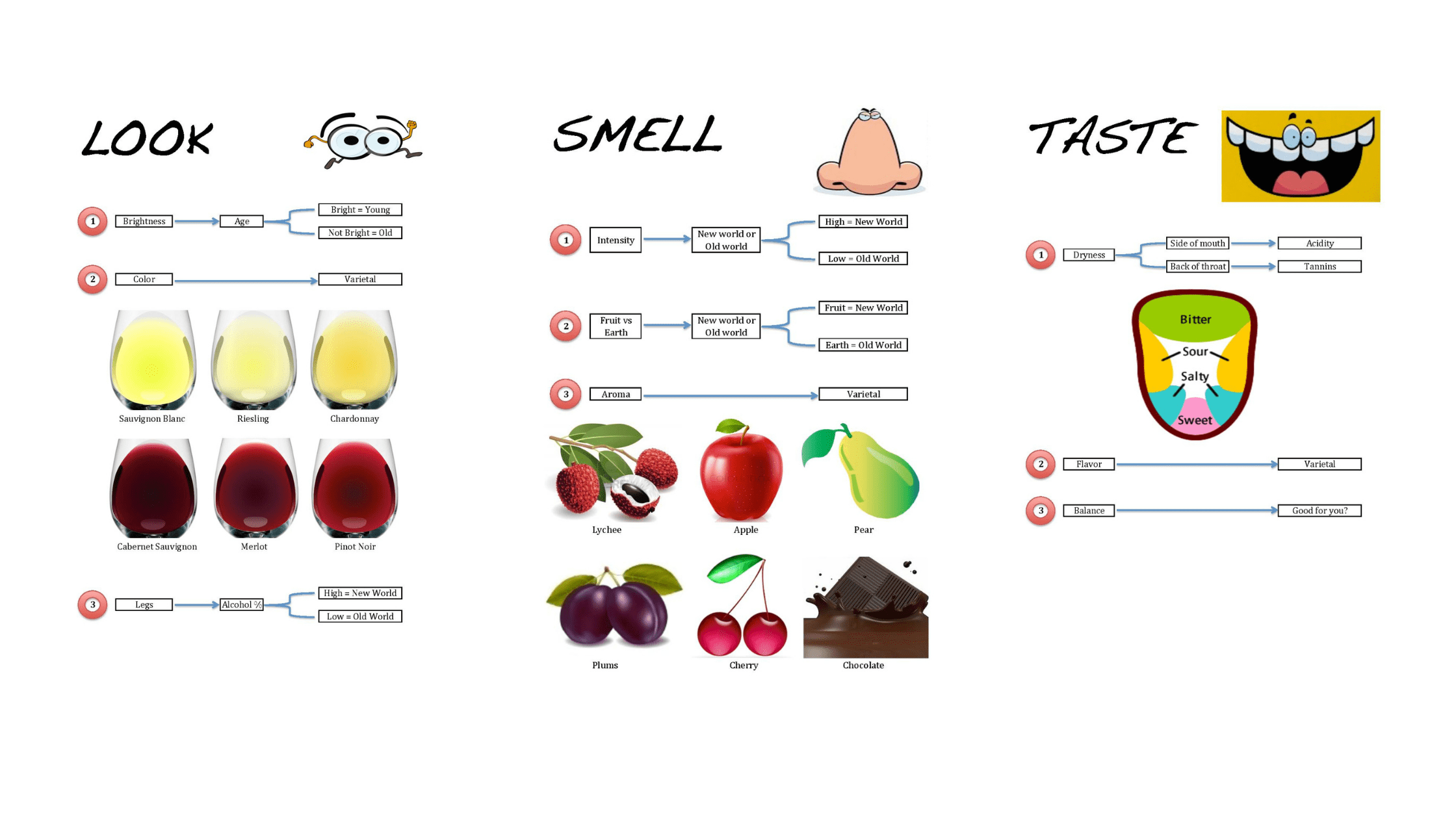
When most people look at wine, I normally get the response: “It looks red.” or “It looks white.” To know anything further about the wine most would think that you’d have to taste it.
But, just like looking at food can tell you a lot of about what you’re going to eat, taking the time to look at wine will tell you a lot about what taste to expect. By just spending a few moments inspecting the wine you can get so much information. It will give you clues about the wine that you’ll be able to build upon and confirm as you smell then taste.
Color – Look at the color of the wine, not just if it’s white or red, but notice if it’s a darker red or a lighter red. The shade of the wine can tell you the varietal, but it can also tell you how old the wine is. Unless you are doing a blind taste, you should know the grape you’re drinking, so the color should give you more a sense of the age:
For white wine: the darker the color the older, the lighter the color the younger
For red wine: the darker the color the younger, the lighter the color the older
Rim vs Core – This is another indication of the age of the wine. Notice the difference between the color of the center of the wine (Core) versus the color of the edge of the wine (Rim). If there is a significant difference than you have a more aged wine.
Legs/Tears – The Legs/Tears are the liquid tracks that form on the side of the glass after swirling the wine. We can learn a lot about the alcohol % in the wine from the movement of the legas.
The slower the legs fall on the side of the glass, the more alcohol the wine has.
The faster the legs fall on the side of the glass, the less alcohol the wine has.
“Wow the rim of the glass is brick red, this must be an older wine…”
“oh the legs are a bit slower so this wine must have a good amount of alcohol…”
FYI – A good swirl is a must to look cool. We will go through how to do this below…
**WineO Tip – When looking at wine NEVER hold the wine glass up over your head to look at the wine. This just won’t help at all and you’ll look a bit silly doing that. You should just tilt the glass at a ~45 degree angle parallel to the tabletop with a white background underneath your glass.
Most of the time when eating food, you don’t take time to smell the food. You might get a whiff of it as you’re sticking it in your mouth, but you aren’t consciously sniffing it beforehand. Most people would think that your tongue does most of the tasting, but actually 80% of your taste comes from smell. Ever try eating when you have a stuffy nose and everything tastes bland?
That’s why smelling is the most important part of wine tasting. You can learn the most from smelling.
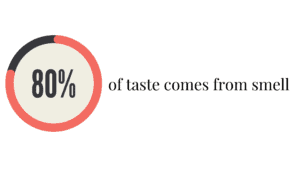
Smell is also incredibly important for wine tasting because wine has the amazing ability to smell like many different types of aromas. This is what makes wine fun! No wine makers add cherry into the wine or lemon into the wine. None of these ingredients are actually placed into the wine. Aromas are created by the chemical compounds that appear once the grapes are fermented. If you take time to smell your food, you’ll start noticing similar scents when smelling wine.
Some experts say you have a dominant nostril (right or left), like your hands, and will recommend sticking that side of the nose towards the glass. Others will say you should take one large sniff, and even others say you should take small short sniffs.
But really you can just sniff like you normally would if you were smelling flowers or food. Any way you feel comfortable that allows you to actually collect information on the wine is fine.
**WineO Tip – Before you smell, make sure you swirl the wine. Swirling brings out the aroma in wine. The wine in the bottle is a living thing that is always evolving. It has been stuck in the bottle for at least 2 years. You need to let it breathe and the best way to accelerate that is to swirl.
Hold the glass by the stem and draw little circles fast. Wine glasses are made so that you can swirl wine, so be confident and give it a good strong fast swirl. This is one way to look like you know what you’re doing.
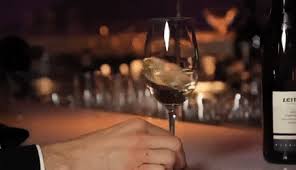
Fruit vs Earth – Do you smell earthiness or fruit in your wine right off the bat?
If you smell Fruit, the wine could be telling you that it is from the New World (all wine regions outside of Europe) For example: US, Australia, South Africa
If you smell Earth, the wine could be telling you that it is from the Old World (all wine regions in Europe) For example: France, Italy, Spain
Fruits – While obviously smelling of grape, wines also have the aromas of other fruits. The color of the wine can tell you what fruits to expect.
If it’s a red wine, think of red/dark fruits. For example: cherry, plum, blackberry…
If it’s a white wine, think of white fruits. For example: peach, grapefruit…
Secondary Aromas – Besides fruits there can be other interesting aromas in wine
If it’s red wine, think chocolate, coffee, leather
If it’s white wine, think floral, mineral, grass
“I smell some cherries, plum, and a hint of chocolate…”
“I get a lot of earthiness, is this from the old world?”
The most important thing when you smell these fruits or other aromas, is to be confident when you say them out loud. That’s how you look cool. The fact is, there are no fruits or scents that are actually added to the wine, so you can never really be wrong. The aromas that you smell are singular to you. Remember wine is subjective. Your lemon smell is different than any other person’s lemon smell.
So just say what you smell with confidence!

The best part of tasting wine is the actual tasting of the wine. Remember what you saw and smelled, the tasting just confirms what you already learned from the wine.
Some sommeliers and wine experts like to create an O with their mouth while drinking wine. They drink the wine while sucking in air and this makes a slurping sound. They do this because the oxygen intensifies the aromas and flavors they’re evaluating. While theoretically correct, there’s really no need as an everyday drinker to drink wine in this way.
Taste like you would good food. You don’t need to drink in any fancy way, but don’t just scarf it down. Enjoy it. Savor it. Think about all the flavors that you are tasting.
Think about the acidity, dryness, the sweetness.
Is there a good balance of alcohol, fruit, acidity?
Does the wine have a pleasant finish? Lots of tannins?
Just give yourself time to think about these questions. But most importantly enjoy the wine!
Look at the Wine – Tilt the glass ~45 degrees from the tabletop
Swirl Confidently – Make strong and fast little circles. The wine glass is made so that the wine doesn’t spill over.
Smell the Wine – Remember this is SUBJECTIVE. So if it’s a red wine, name some red fruits. If it’s a white wine, name some white fruits
Taste the Wine – Simply drink and enjoy. Talk about the balance, the fruit, the acidity, and the tannins.

Best Lunch In Napa – Our 12 Favorite Spots! Lunch is a must when you’re out wine tasting! Whether you’re in the mood for a

North Coast Wine Co. Outerbound Pinot Noir – WineO Mark Review Wine Stats Grape Variety: 100% Pinot Noir Vintage: 2019 ABV: 14% Wine Region: North Coast,

Böen Pinot Noir – WineO Mark Review Wine Stats Grape Variety: 100% Pinot Noir Vintage: 2021 ABV: 14.6% Wine Region: California Flavor Profile: Cherry, raspberry, blackberry,

Merry Edwards Sauvignon Blanc – WineO Mark Review Wine Stats Grape Variety: 100% Sauvignon Blanc Vintage: 2022 ABV: 14% Wine Region: Russian River Valley, California
